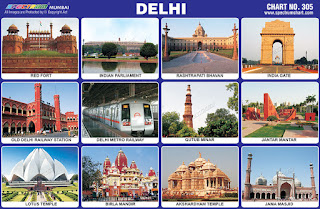 |
| Delhi Chart |
Spectrum Chart - 305 : Delhi
1. Red Fort - Red Fort was the residence
of the Mughal emperor for nearly 200 years, until 1857. It is located
in the centre of Delhi and houses a number of museums. Constructed in
1648 by the fifth Mughal Emperor Shah Jahan as the palace of his
fortified capital Shahjahanabad, the Red Fort is named for its
massive enclosing walls of red sandstone. It is designated as a
UNESCO World Heritage Site as part of the Red Fort Complex.
2. Indian Parliament - Sansad
Bhawan (Parliament Building) is the house of the Parliament of India,
located in New Delhi. Construction of
parliament house began in 1921. The opening ceremony of the
Parliament House was performed on 18 January 1927 by Lord Irwin, the
then Viceroy of India.
3. Rashtrapati Bhavan - The Rashtrapati
Bhavan is the official home of the President of India, located in New
Delhi. It includes a mansion of 340-rooms that has the President's
official residence, halls, guest rooms and offices.
4. India Gate - India Gate is a war
memorial located astride the Rajpath in New Delhi.
India gate is a memorial to 82,000 soldiers of the undivided
Indian Army who died in the period 1914–21 in the First World War.
In 1971, following the Bangladesh Liberation war. Structure called
Amar Jawan Jyoti, has served as India’s Tomb of the Unknown
Soldier.
5. Old Delhi Railway Station - Old Delhi
Railway Station is the oldest railway station of Delhi city and a
Junction station. It was established near Chandni Chowk in 1864 when
trains from Howrah, Calcutta started operating up to Delhi. Its
present building was constructed by the British Indian government in
the style of nearby red-coloured fort and opened in 1903.
6. Delhi Metro Railway – The Delhi Metro
is a metro system serving Delhi and its satellite cities of
Faridabad, Gurgaon, Noida and Ghaziabad in National Capital Region.
Delhi Metro is the world's 12th largest metro system in terms of both
length and number of stations. The system has a mix of underground,
at-grade, and elevated stations using both broad-gauge and
standard-gauge. The metro has an average daily ridership of 2.4
million passengers.
7. Qutub Minar - Qutub Minar at 120
meters, is the tallest brick minaret in the world. Qutub Minar, along
with the ancient and medieval monuments surrounding it, form the
Qutub Complex, which is a UNESCO World Heritage Site. The
construction of Qutub Minar was commissioned by Qutub-ud-Din Aibak,
the founder of the Delhi Sultanate in 1199 AD.
8. Jantar Mantar - The Jantar Mantar is
located in the modern city of New Delhi. It consists of 13
architectural astronomy instruments. The primary purpose of the
observatory was to compile astronomical tables and to predict the
times and movements of the sun, moon and planets. Some of these
purposes nowadays would be classified as astronomy.
9. Lotus Temple - Lotus Temple, located in
New Delhi, is a Bahai House of Worship was completed in 1986. Notable
for its flower like shape, it serves as the Mother Temple of the
Indian subcontinent. Lotus Temple is open to all, regardless of
religion or any other qualification.
10. Birla Mandir - Birla Mandir also known
as the Laxminarayan Temple is a hindu temple, up to large extent
dedicated to Lord Laxminarayan in Delhi. Laxminarayan usually refers
to Lord Vishnu. The temple is one of the major attractions of Delhi
and attracts thousands of devotees on the festivals of Janmashtami
and Diwali.
11. Akshardham Temple – Akshardham Temple
is a hindu mandir and a spiritual-cultural campus in New Delhi. The
complex displays millennia of traditional Hindu and Indian culture,
spirituality and architecture. The mandir consists of 234 ornately
carved pillars, nine domes and 20,000 murti's of sadhus, devotees and
acharyas.
12. Jama Masjid - Jama Masjid of Delhi, is
one of the largest mosques in India. It was built by Mughal emperor
Shah Jahan. The mosque was completed in 1656 AD with three great
gates, four towers and two 40 m high minarets constructed of strips
of red sandstone and white marble. The courtyard can accommodate more
than 25,000 persons.

No comments:
Post a Comment